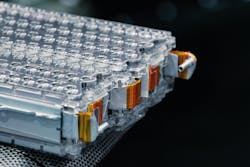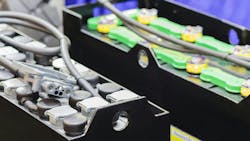Power the Future By Choosing the Right Battery Technology
In today’s increasingly electrified landscape, batteries have become fundamental components powering a diverse range of industrial applications. They offer a convenient and portable way to provide power.
However, with a vast array of battery types available, choosing the best option for each unique application can be a daunting task.
Understanding Battery Basics
Batteries function by storing energy in the form of chemical potential energy. The chemicals within a battery react to produce electricity once a circuit is complete which is used to power a device or equipment. Common uses of batteries are categorized into four main areas:
- Starting: Encompasses applications where batteries provide a surge of power to initiate operation, such as starting a car engine.
- Standby Use: Includes batteries used in uninterruptible power sources (UPS) or backup power systems to provide temporary power during outages.
- Deep Cycle Batteries: Designed for applications requiring sustained power delivery over extended periods, such as powering RVs.
- Traction Use (also known as deep cycle use): Includes batteries used in electric-powered industrial equipment.
Battery power is measured in two key units: voltage and amp hours. Voltage refers to the electrical pressure within the battery and is analogous to water pressure in a pipe. Amp-hours represent the amount of current a battery can deliver over time. Together, these measurements determine the total power output of a battery and the duration that it can sustain that power level.
Two Primary Battery Choices
Batteries for electric vehicles can broadly include two main groups: Lead-acid and lithium-ion. Various chemistries tailored for specific applications exist within these categories. Lead-acid batteries are a well-established technology that offers a reliable and cost-effective solution for many applications. Lead-acid battery chemistries include flooded lead-acid batteries, gel lead-acid batteries, and Absorbed Glass Mat (AGM) batteries. Each type offers unique advantages and considerations.
Lithium-ion battery chemistries are renowned for their high energy density, meaning a smaller size of battery can store more energy compared to lead-acid batteries. This makes them ideal for applications requiring lighter batteries and extended runtime. Popular lithium-ion battery chemistries include Lithium Iron Phosphate (LiFePO4), Lithium Nickel Manganese Cobalt (LiNiMnCoO2), and Lithium Cobalt Aluminum Oxide (LiNiCoAlO2).
Advanced battery charging systems boast the capability to charge both lead-acid and lithium-ion battery chemistries. They may offer a robust selection of charging profiles to optimize charge time and battery life.
READ MORE: The Current State of Battery Technology
Pros and Cons of Lead-Acid Batteries
Lead-acid batteries can be further categorized into two types, with flooded lead-acid batteries being the most common and readily available type. They are generally an affordable option, offering the lowest upfront cost compared to other battery types. Users have trusted their proven technology for decades.
Unlike some other battery types, flooded lead-acid batteries offer tolerance for user error. Adding more electrolytes can remedy the situation if users accidentally overcharge these batteries. Another benefit of flooded lead-acid batteries is their wide operating temperature range, making them a good choice for applications operating in extreme temperatures.
However, it is important to consider the maintenance requirements associated with flooded lead-acid batteries. They require periodic topping up with water to maintain proper electrolyte levels. Additionally, they may require equalization of charging cycles, and the specific gravity of the electrolyte needs to be measured with a hydrometer to ensure optimal performance and lifespan.
Another potential drawback to flooded lead-acid batteries is the need for venting. During specific charging conditions, they may off-gas dangerous hydrogen fumes. Additionally, flooded lead-acid batteries are the heaviest of all the energy storage solutions. However, this can make them well-suited to applications where weight is not an issue or where equipment requires weight for counterbalance, such as material handling equipment. But these batteries are limited in their orientation as they are susceptible to spills.
Finally, flooded lead-acid batteries can be prone to higher self-discharge losses, meaning they lose some stored energy, even when not in use.
The second type of lead-acid batteries is sealed lead acid (SLA) batteries, also called valve-regulated lead acid (VRLA) batteries. This category includes AGM and gel batteries. Sealed lead-acid batteries offer several advantages over their flooded counterparts. Compared to flooded lead-acid batteries, they have reduced maintenance requirements, and there is no need to add electrolytes. Their sealed design allows them to be placed in various orientations, including on their side, offering much greater flexibility in installation.
Additionally, they are spill-proof, making them ideal for applications where no acid spillage is required, such as hospitals, food services, government, and educational institutions.
However, there are some trade-offs to consider with sealed lead-acid batteries. While they are still less expensive than lithium-ion batteries, sealed lead-acid batteries have a higher upfront cost compared to flooded lead-acid batteries. Overcharging and fast charging can lead to off-gassing and loss of electrolytes. Unlike flooded lead-acid batteries, there’s no way to replenish lost electrolytes, potentially impacting lifespan.
Many battery vendors require precision charging to maintain a warranty. This might involve a new charge profile and, in some cases, even a new charger. Charger features like temperature sensors to regulate exact charge and custom charge profiles or algorithms can offer a customized approach that prolongs battery life.
READ MORE: Battery Sizing Key First Step in Electric Vehicle Development
The Advantages Offered by Lithium-Ion Batteries
Lithium-ion batteries have some significant advantages when compared to lead-acid batteries. One key benefit is their high power density. They can be up to 30% lighter than their lead-acid counterparts. This lighter weight is especially valuable for applications where space and weight are considerations, like electric vehicles or small portable devices.
Lithium-ion batteries boast significantly higher efficiency with lower power losses and dramatically reduced charging time. Additionally, they offer a remarkable improvement in cycle lifetime and longer runtime. Lithium-ion batteries can last over a staggering 5,000 cycles, whereas lead acid batteries typically last 400-1,000 cycles. Finally, lithium-ion batteries offer exceptional voltage stability, providing a consistent power output through their discharge cycle.
Lithium-ion batteries are virtually maintenance-free. Unlike lead-acid batteries, they do not require watering or terminal cleaning. In today’s environment with labor shortages and rising wages, they are an attractive option, freeing up employee’s valuable time for other critical tasks.
Lithium batteries are either smart or standard. Smart lithium batteries incorporate a battery management system (BMS) that facilitates improved communication between batteries, batteries and chargers, or batteries and operators. They usually utilize controller area network (CAN) protocol, enabling real-time data exchange. Modern BMS boast a rugged build that is ideal for industrial applications.
Smart lithium-ion batteries typically have more built-in safeguards to prevent premature failures or damages. They can handle higher discharge and charge currents reliably and safely compared to standard lithium-ion batteries. Some advanced BMS also incorporate other bells and whistles, like heating, to allow for low-temperature charging. In contrast, standard lithium energy storage products tend to offer little to no communication capabilities. Some may come with a simple Bluetooth application, but this usually only provides some general information.
While lithium-ion batteries are a popular choice for many applications, they aren’t without drawbacks, and in some cases, lead-acid batteries may be a better fit. Cost is a major factor to consider. Lithium-ion batteries typically have a higher initial cost, ranging from two to four times more expensive.
Operating temperature also plays a role; lithium-ion batteries do not perform well in extreme weather. They perform best at temperatures between 5 and 20 C (41 and 68 F). If it gets too cold, it can result in a loss of capacity, and in some cases, the BMS may prevent them from charging at temperatures below 0 C (32 F).
Environmental impact is another consideration. While improvements are being made, the recycling process for lithium-ion batteries is not well established and can be costly. It is also important to consider integrating existing equipment such as displays, motors, and controllers.
Finally, lithium-ion batteries have the potential for thermal runaway, a situation that occurs when an increase in temperature changes the conditions in a way that triggers further heating. To mitigate this risk, some lithium-ion batteries utilize CAN-compatible chargers along with a BMS. Together, they add an extra layer of protection by monitoring battery temperature and preventing thermal runaway situations.
READ MORE: Navigating the Complexities of Battery and Charger Integration for Electric Vehicles
Deciding Between Lead Acid or Lithium-Ion
Ultimately, selecting an appropriate battery and charging system boils down to the fleet’s specific operational requirements and broader electrification objectives. Cost, weight requirements, communication needs, and operating environment should all be considered when choosing the battery technology that best suits the application.
By understanding the strengths and weaknesses of both lead-acid batteries and lithium-ion batteries, battery users can ensure optimal performance and efficiency in all their electrified endeavors.
This article was written and contributed by Hiroshi Hasegawa, Customer Success Manager at Delta-Q Technologies.






